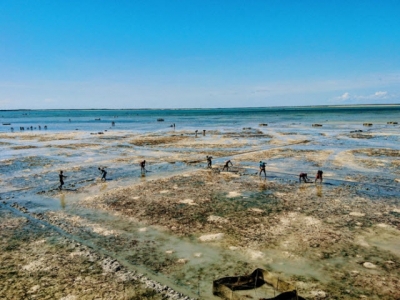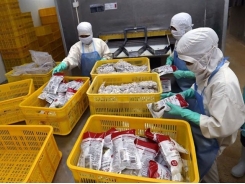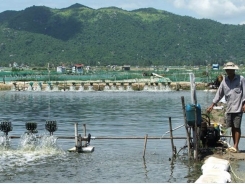Sea cucumber project redefining traditional farming in Madagascar

Blue Ventures’ revamped aquaculture program helps marine conservation in an impoverished nation
Tampolove’s Bay of Assassins in Madagascar, north of Toliara, has optimal growing conditions for sea cucumbers, with shallow waters rich in sediment. All photos courtesy of Blue Ventures.
On upscale menus across China, where they command a premium as an aphrodisiac, sea cucumbers are often unappetizingly labeled sea slugs. Half a world away, in Madagascar where they are fondly referred to as zanga, these curious echinoderms are produced in shallow sea waters rich with nutrients. Farming them is changing people’s lives, giving rural workers a potential pathway out of poverty. Madagascar is one of the poorest nations in the world.
The white sea cucumber (Holothuria scabra) is a simple creature. Enabling the sustainable growth of this niche industry in Madagascar, however, has been anything but. Skin Ulceration Syndrome (SUS), a bacterial infection with an unknown etiology that causes the creatures’ death in as little as three days, forced the closure of an important farm in a southwest area of the African island in 2015. The following year, Blue Ventures brought in consultant Timothy Klückow to set a new course.
While Tampolove’s Bay of Assassins (about a six-hour drive by 4×4, north of the region’s capital, Toliara) has optimal conditions for H. scabra, Klückow – now the aquaculture program coordinator for Blue Ventures – found that stocking densities had a profound impact on the creatures’ growth and survival rates.
“We were overstocking, definitely, in some pens. That wasn’t just Blue Ventures, that was worldwide,” said Klückow.

Sea cucumbers are inspected and weighed before sale.
Industry standard for sea cucumber farming is to stock about 1.5 individuals per square meter and to harvest at about 350 grams per individual – just before the animals reach a plateau of no further growth.
Feeling this method was underutilizing the area and lowering production capacity, the fifth-generation Zimbabwean spent six months monitoring 32 4-square-meter pens and nine 16-square-meter pens each stocked with 50 animals weighing about 28 grams.
“Same animals, same environment, same timeframe,” but different densities. Divergence in growth rates did not occur until 467 grams, confirming that the standard density dependent growth restriction was lower than the sediment’s maximum carrying capacity.
Klückow then developed a complex growth-modeling calculator to determine that 150 animals will be sequentially stocked every 30 days. If biomass begins to stall, big animals can be harvested earlier, cutting biomass density and allowing for juveniles to be introduced.
“When you’re working in an extensive aquaculture model, you have no control over feed inputs because it is something that is naturally derived from the ocean each day. So, you have to understand the carrying capacity for sediment very well,” said Klückow. “And you need to stock in order to match that. Otherwise you are underutilizing, or worse, putting in far too much biomass.”
Ideally, this will allow Blue Ventures to harvest 100 animals at 450 grams per farm per month for 4,000 ariary (about $1.30) per animal.
“If you’re eating something that is supposed to be phallic in nature, you want it to be a bit bigger,” joked the 30-year-old during an interview at a hotel restaurant in Toliara; the sound of hundreds of rickshaw bicycles (pousse pousse) screeching in the background.

Blue Ventures has an integrated approach within locally managed marine areas that is providing quick, tangible benefits to a community of rural farmers in Madagascar.
Blue Ventures’ partner, Indian Ocean Trepang (IOT) – a company breeding H. scabra – is also based in Toliara, and Klückow expected to receive new juveniles from them in January. Blue Ventures’ first sales back to IOT – for export to Asia – are anticipated for fall 2018.
Before ceasing production, Blue Ventures along with IOT and Norwegian investor Norges Vel (who will continue funding the program) already had helped the local Vezo people sell 40,000 H. scabra, earning a total of $16,000. For a community of about 550 people surviving on an income of less than $2 a day, it was significant.
Having eliminated fallowing periods and nurseries (which his research revealed were unnecessary expenses), standardizing pen shapes and sizes, and addressing a theft problem, Klückow expects future profits to be more lucrative.
“It’s a huge waste of money if you’re putting in zanga, and they’re not surviving or getting stolen,” he said.
The losses motivated Klückow to help create new local procedures so that Dina –customary laws – could be enforced. “It was rare that somebody would persecute their neighbor because everyone is very close,” he explained.
Klückow also developed a full-time rotational security system mixing third-party guards and farmers as well as a point system that punishes farmers for missing meetings and guard duties. Accumulate three penalties in six months and the farm contract is passed along to the next farmer on the waiting list.
Another key was hiring Ben Parker, Blue Ventures’ aquaculture operations assistant, to build a new watchtower. The state-of-the art structure, dubbed El Mirador after the pre-Columbian Mayan settlement meaning “the looker,” is complete with solar-powered electricity and an alarm.
“It needed to be a place where people are willing to spend 12 hours a night. It’s not an onerous duty,” said Klückow, who voluntarily works from the scenic wooden fort, high tide trapping him there for hours.

A new watchtower, dubbed El Mirador after the pre-Columbian Mayan settlement meaning “the looker,” is complete with solar-powered electricity and an alarm.
So far, the system has shown promise. Late last year, thieves were caught red-handed, a lawsuit was filed, and the thieves paid a fine. Nothing has been stolen since.
The University of Edinburgh and the Prince of Albert II of Monaco Foundation have taken notice and jumped onboard, and Blue Ventures is already looking to expand to northern Madagascar where Klückow thinks the sediment looks “fantastic.” But it’s the potential for long-term change that truly excites him.
“It’s probably one of the greatest opportunities I’ve seen in aquaculture for coastal communities,” he said. No feed inputs mean low overhead and maintenance, and exporting them sun-dried eliminates cold chain requirements, making the detritivores ideal for Madagascar’s extremely remote conditions and challenging infrastructure.
Liz Day, southwest regional manager in Madagascar for Blue Ventures, shares Klückow’s enthusiasm.
“Blue Ventures has an integrated approach within locally managed marine areas and for that to work, we must offer quick, tangible benefits to the community,” she said. “Aquaculture is a real game changer in terms of poverty alleviation and sustainable developments.”
Có thể bạn quan tâm
Phần mềm

Phối trộn thức ăn chăn nuôi

Pha dung dịch thủy canh

Định mức cho tôm ăn

Phối trộn phân bón NPK

Xác định tỷ lệ tôm sống

Chuyển đổi đơn vị phân bón

Xác định công suất sục khí

Chuyển đổi đơn vị tôm

Tính diện tích nhà kính

Tính thể tích ao hồ



 Đồng Tháp farmers bet on tra fish
Đồng Tháp farmers bet on tra fish  Solutions sought for sustainable fishery in Phu Yen
Solutions sought for sustainable fishery in Phu Yen